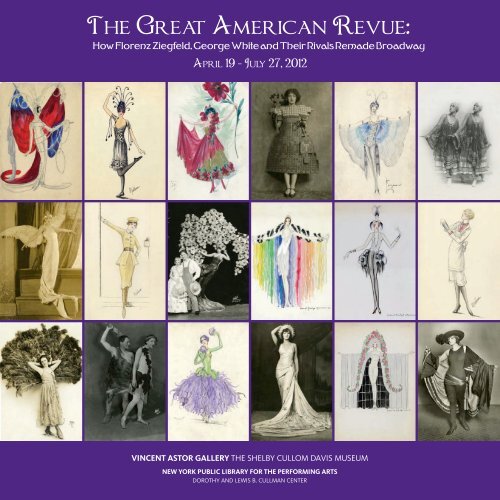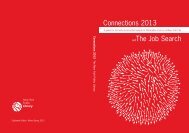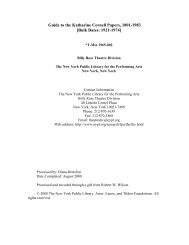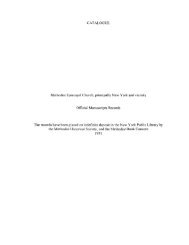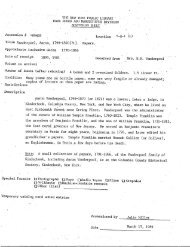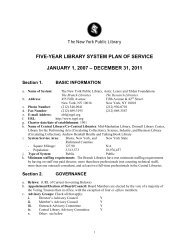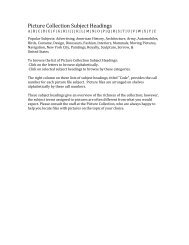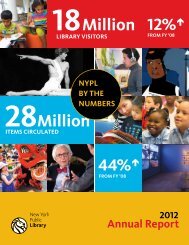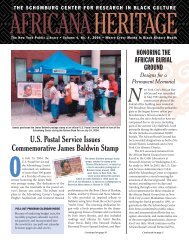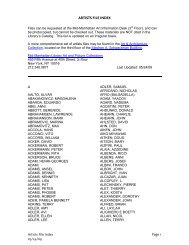The Great American Revue: - New York Public Library
The Great American Revue: - New York Public Library
The Great American Revue: - New York Public Library
You also want an ePaper? Increase the reach of your titles
YUMPU automatically turns print PDFs into web optimized ePapers that Google loves.
<strong>The</strong> <strong>Great</strong> <strong>American</strong> <strong>Revue</strong>:<br />
How Florenz Ziegfeld, George White and <strong>The</strong>ir Rivals Remade Broadway<br />
April 19 - July 27, 2012<br />
VINCENT ASTOR GALLERY THE SHELBY CULLOM DAVIS MUSEUM<br />
NEW YORK PUBLIC LIBRARY FOR THE PERFORMING ARTS<br />
DOROTHY AND LEWIS B. CULLMAN CENTER
3<br />
What are<br />
<strong>Revue</strong>s?<br />
In our fantasies, fed by nostalgia and Hollywood, they<br />
are concoctions of songs, dance, elaborate costumes and<br />
semi-nudity. To devotees of the <strong>American</strong> Songbook, they<br />
were the laboratories in which Berlin, Rodgers & Hart,<br />
Schwartz, Gorney, Harburg, Rome, and many others<br />
learned to ply their craft. To historians, they are editorial<br />
cartoons, preserving contemporary responses to Suffrage,<br />
Prohibition, World War I, and the other topical, political<br />
and cultural concerns of their day.<br />
<strong>Revue</strong>s are too often defined by what they were not –<br />
musicals or vaudeville. <strong>The</strong>y appeared on Broadway but<br />
were not musical comedies or operettas, since those<br />
genres were written to character around plots. <strong>The</strong>y<br />
respected the specialties of performers, but were not<br />
vaudeville, since the selection and order of acts were<br />
curated, provided with a consistent vision determined by<br />
a producer or director. Although there were many single<br />
shot revues, the exhibit focuses on Broadway revues with<br />
multiple, annual editions.<br />
“<strong>The</strong> Follies Salad,” which opened the Ziegfeld Follies of 1920. Photograph by White Studio.
4<br />
Why did <strong>Revue</strong>s become<br />
so popular in the early<br />
20 th century?<br />
<strong>Revue</strong>s responded to a confluence of 3 urban and 3 cultural influences:<br />
Top: Promotional photograph of George White (far left) and male<br />
cast members of the Scandals of 1926.<br />
❖<br />
❖<br />
❖<br />
❖<br />
❖<br />
❖<br />
A swell of general interest in political and cultural news, fed by<br />
<strong>New</strong> <strong>York</strong>’s 13 daily papers<br />
Extension of the Times Square/Broadway performance calendar<br />
to include summer productions, thanks to improvements in air<br />
conditioning and elevators<br />
Vaudeville’s success at marketing to specific audiences led revue<br />
producers to focus on “summer widowers,” businessmen whose<br />
families left the city for summer<br />
Popularity of imitations as a performance specialty, especially as<br />
practiced in vaudeville and roof garden shows<br />
Radical changes in social and theatrical dance, each in turn was<br />
integrated into revues<br />
<strong>The</strong> new phenomenon of frequent Broadway runs for African<br />
<strong>American</strong> musical comedies. Although plot dependent (and<br />
therefore not included in the exhibition), they introduced revues to<br />
the songwriters and arrangers of syncopation, blues and jazz.<br />
Bottom: “Brother, Can You Spare a Dime,” as introduced in<br />
<strong>American</strong>a, 1932. Photograph by White Studio.<br />
Right: Designs for the “Lampland” scenery by Mark Lawson in the<br />
1917 Hippodrome production, Everything. R. H. Burnside Collection.<br />
<strong>Revue</strong> series were linked and named for their “impresarios,” who<br />
could be producer, director and/or theater manager. A revue could be<br />
developed by a settlement house project such as <strong>The</strong> Neighborhood<br />
Playhouse, <strong>The</strong> <strong>The</strong>atre Guild production collective, or the International<br />
Ladies’ Garment Makers’ Union. But the great majority of shows were<br />
commercial ventures. Florenz Ziegfeld, Jr., J. J. and Lee Shubert and<br />
the Hippodrome’s R. H. Burnside were full time producer/directors,<br />
managing multiple musicals as well as the revues series.
5<br />
Developing these shows was a complex balancing act.<br />
<strong>The</strong> producers/directors/impresarios juggled the relative<br />
importance of topical scripts, songs, dance, design, and<br />
performer specialties. Some came from these fields –<br />
Irving Berlin, George M. Cohan, Elsie Janis, Grand Street’s<br />
Agnes Morgan, and Earl Carroll were all songwriters, while<br />
George White was a noted dancer and dance director.<br />
H. Burnside maintained a large studio of male and female<br />
set and costume designers for the Hippodrome shows and<br />
the revues and musical comedies that he produced at other<br />
theaters. Comics often provided their own specialties,<br />
interpolating songs or monologues, giving (small print)<br />
credit to Blanche Merrill or Alex Rogers for Fanny Brice<br />
and Bert Williams acts, respectively.<br />
That balancing act meant that revues had a huge impact<br />
on the <strong>American</strong> performance industries since each<br />
edition could feature multiple designers, directors and<br />
writers for songs and comedy routines. Ziegfeld relied on<br />
Joseph Urban and set and concept designer, but the John<br />
Murray Anderson revues showcased 6 – 8 artists each,<br />
including many of the women designers of the 1920s. R.<br />
What did the revue audience see and hear on stage? What<br />
entertained them and made them laugh? Through scores,<br />
prompt scripts and lyric sheets, posters, photographs,<br />
production notes, and spectacular original designs for sets,<br />
costumes, logos and billboards, the gallery audience can<br />
experience the grandeur and humor of the <strong>Great</strong> <strong>American</strong><br />
<strong>Revue</strong>s, 1907 – 1938.
6<br />
<strong>The</strong> revues series (chronologically by first edition)<br />
Group i: who has the power?<br />
Hammerstein Roof Garden shows<br />
(1902 – 1908)<br />
Focus: Imitation as a performance specialty<br />
Ziegfeld Follies (1907-1925, 1927,<br />
1931, 1934, 1936, 1943, 1957)<br />
Focus: Establishing the structure of revues<br />
by bringing illustrators’ images to life<br />
Passing Shows<br />
(Shubert Brothers, 1912 – 1924)<br />
Focus: Integrating dance specialities with<br />
real life references to Suffrage, local politics,<br />
and biblical epics<br />
Hippodrome revues (1912 – 1920)<br />
Focus: Developing a house image with<br />
multiple designers<br />
Ziegfeld Frolics and Midnight<br />
Frolics (1915 – 1916, 1918-1921, 1929)<br />
Focus: Audience participation in small<br />
revues in roof gardens<br />
<strong>The</strong> Dolly Sisters in their tandem dance specialty in the<br />
Ziegfeld Follies of 1915. Photograph by White Studio.
7<br />
Group ii: balancing the elements<br />
Hitchy-Koo (1917-1922)<br />
Focus: <strong>The</strong> European model of revues as star<br />
vehicles for comics<br />
Music Box <strong>Revue</strong> (1921 – 1924)<br />
Focus: Irving Berlin and the songwriter’s<br />
revue and importance of the national tours<br />
Elsie Janis & Her Gang (1919, 1922)<br />
& Elsie Janis Puzzles of 1925<br />
Focus: Smaller format revues for and by<br />
World War I veterans<br />
Grand Street Follies<br />
(Neighborhood Playhouse, 1920s)<br />
Focus: Self-referential return to imitation<br />
and parodies<br />
Trixie Friganza in the Passing Show of 1912.<br />
George White’s Scandals<br />
(1919-1926, 1928, 1931, 1936, 1939)<br />
& Music Hall Varieties (1932)<br />
Focus: Intimate through fabulous – Scale as<br />
theme in dance, music and design<br />
Garrick Gaieties<br />
(<strong>The</strong>atre Guild, 1925, 1926, 1930)<br />
Focus: Finding a balance for imitators’/<br />
songwriters’ revue<br />
Cohan’s <strong>Revue</strong> (1916, 1918)<br />
aka George M. Cohan <strong>Revue</strong><br />
Focus: Rise of songwriters as major factor in<br />
topical revues<br />
Century <strong>The</strong>ater revues<br />
(Ziegfeld and Dillingham’s Century Girl,<br />
1916, Miss 1917, Century <strong>Revue</strong>, 1920-<br />
1921, and Century Midnight <strong>Revue</strong>, 1920)<br />
Focus: Social and ballroom dance in revues<br />
Greenwich Village Follies<br />
(1919-1925, 1928), aka John Murray<br />
Anderson’s GVF<br />
Focus: Production value by multiple<br />
designers as defining theme<br />
Design by Mark Lawson for Elsie Janis and Her Gang,<br />
1922. R. H. Burnside Collection.
8<br />
Group iii:<br />
the body as<br />
performance<br />
Artists & Models<br />
(Shubert Brothers, 1923 – 1925, 1927,<br />
1930, 1943)<br />
Focus: Establishment of series identity<br />
through graphics, scripts, etc.<br />
Earl Carroll’s Vanities (1923 –<br />
1926, 1928, 1930—1932, 1940)<br />
& Sketchbooks (1929, 1935)<br />
Focus: Survival of the tableau vivant<br />
Group iv:<br />
political<br />
satires<br />
<strong>American</strong>a, As Thousands Cheer, Life<br />
Begins at 8:40, and Pins & Needles.<br />
Focus: <strong>The</strong> changing role of modern dance<br />
and ballet in revues<br />
Top Left: Promotional palette design for the Artists &<br />
Models series.<br />
Top Center: Letitia Ide and José Limón in the “Heat<br />
Wave” sequence in As Thousands Cheer. Photograph by<br />
Vandamm Studio.<br />
Top Right: Dancers as Cocktails in the Passing Show<br />
of 1919.<br />
Above: Photograph of “<strong>The</strong> Birth of the Blues” sequence in the George White Scandals of 1926, used as the centerfold<br />
of G. Maillard Kesslere’s Art Impressions souvenir brochure.
9<br />
Three political-cultural topics were so entrenched in the period that they<br />
were featured in every contemporary revue series.<br />
❖<br />
<strong>The</strong> popularity of the Russian ballet made specific ballets and<br />
dancers show up in most of the revue series from 1910 – 1926, with<br />
frequent parodies of Scheherazade and pun-filled characters based<br />
on Pavlova, Mordkin and Nijinsky.<br />
❖<br />
In the World War I era, revues began to address their public’s<br />
concerns with benefit events for refugees before America entered<br />
the War and continues through Elsie Janis’ work with veterans<br />
and the Bonus Army in the 1920s. In the seasons between, revues<br />
presented patriotic pageantry and comedy about taxes and rationing,<br />
and listed performer and writers’ military ranks in their programs.<br />
❖<br />
Prohibition was feared as a threat to <strong>New</strong> <strong>York</strong>’s entertainment/<br />
tourism industries and detested by Broadway script and song<br />
writers. From Raymond Hitchcock’s Hitchy-Koo monologue a few<br />
weeks before enactment to the annual variations of “Three Mile”<br />
jokes, they played to their audience’s knowledge of ways around the<br />
Amendment’s provisions.<br />
<strong>Revue</strong>s provided visibility to generations of performers, designers,<br />
directors, choreographers, writers, and songwriters who went on to redefine<br />
Broadway, films, television, and popular entertainments. <strong>The</strong><br />
form has never disappeared. Hollywood adopted the form to usher in<br />
the sound era, with each surviving studio presenting its own all-singing<br />
revue. Many of the Broadway series continued or resumed into the 1940s.<br />
<strong>Revue</strong>s led by comics such as Bert Lahr proved popular into the 1950s on<br />
Broadway. Since the 1960s, Off-Broadway and night club revues flourish<br />
in the pattern of the Grand Street Follies and Garrick Gaities, celebrating<br />
song writing and social satire.
Credits &<br />
Acknowledgments<br />
<strong>Public</strong> Programs<br />
Wednesdays at 6:00 p.m.<br />
<strong>The</strong> <strong>Great</strong> <strong>American</strong> <strong>Revue</strong>: How Florenz Ziegfeld, George<br />
White and their Rivals Remade Broadway is a project<br />
of <strong>The</strong> <strong>New</strong> <strong>York</strong> <strong>Public</strong> <strong>Library</strong> for the Performing<br />
Arts: Jacqueline Z. Davis, Barbara G. and Lawrence A.<br />
Fleischman Executive Director; and curated by Barbara<br />
Cohen-Stratyner, Judy R. and Alfred A. Rosenberg<br />
Curator of Exhibitions, <strong>The</strong> <strong>New</strong> <strong>York</strong> <strong>Public</strong> <strong>Library</strong> for<br />
the Performing Arts, and Karen Nickeson, Curator, Billy<br />
Rose <strong>The</strong>atre Division, with the collaboration of many LPA<br />
staff members. It was developed and installed by installed<br />
by <strong>The</strong> <strong>Library</strong>’s Performing Arts Museum staff: Barbara<br />
Cohen-Stratyner, Judy R. and Alfred A. Rosenberg Curator<br />
of Exhibitions; Caitlin Mack, designer; and installers Rene<br />
Ronda and Herbert Ruiz; Michael Diekmann, Manager of<br />
Media Playback and Interactive Design.<br />
Panels developed by Gary Flannery with Cheryl Raymond,<br />
Manager of <strong>Public</strong> Programs; Film programming by John<br />
Calhoun, Reserve Film & Video Collection.<br />
Artifacts and media from the Research Divisions of <strong>The</strong><br />
<strong>New</strong> <strong>York</strong> <strong>Public</strong> <strong>Library</strong> for the Performing Arts. Additional<br />
material from the Gary Flannery Collection. Our thanks<br />
to Jane Lahr and Lyn DelliQuadri for their support of this<br />
project. We thank the staff for their support and assistance<br />
on this exhibition and the ongoing preservation of artifacts<br />
from the revues.<br />
We are grateful to the volunteers and interns who have<br />
contributed to this project: Mana Allen, Claire Barco,<br />
Daphne Delacruz, Susan Donahue, Victoria Flexner,<br />
Kristin Holzer, Stephanie Liff, Clementine Martinez,<br />
Allison Mikulewich, Hannah Orlove, Daniel Pecoraro,<br />
Christina Ramos, Lauren Reinhalter, Samantha Shaffer,<br />
Sarah Shears, Emma Winter Zeig, and Christine Zhu.<br />
Programs take place in the Bruno Walter Auditorium. Admission is free<br />
and on a first come, first served basis. For Sunday afternoon programs,<br />
please enter by 111 Amsterdam Avenue just south of 65 th Street; doors<br />
open 30 minutes prior to the program. For further information about<br />
programs, call 212.642.0142.<br />
May 2<br />
<strong>Great</strong> <strong>American</strong> <strong>Revue</strong> composers like Gershwin, Berlin, Porter,<br />
Rodgers, and De Sylva, Brown & Henderson changed music in<br />
America and around the world by setting new standards for Broadway<br />
and Hollywood scores. Take a musical journey with cabaret artist<br />
Steve Ross through 4 decades of songs brought to you by the <strong>Great</strong><br />
<strong>American</strong> <strong>Revue</strong>s. Featuring: Peter Mintun, Stephen Cole, and Nicholas<br />
Wuehrmann & the Grads.<br />
June 13<br />
Dance in the <strong>American</strong> <strong>Revue</strong>, like the Roaring Twenties themselves,<br />
was buoyant, frantic, and full of ingenuity, creating trends that exist to<br />
this day. While the Castles and the Astaires brought the art form to<br />
domestic parlors, ballrooms were full of Flappers invited to “Charleston”<br />
their way to happiness! Join our hosts, legendary dancers Marge<br />
Champion and Gary Flannery for an energetic evening with costumed<br />
Ziegfeld re-creations and demonstrations of the Era’s dance crazes by<br />
Jerry Mitchell and the Broadway Bares Company.<br />
June 20<br />
<strong>The</strong> pioneers of the <strong>Great</strong> <strong>American</strong> <strong>Revue</strong> forever changed musical<br />
theater and film, and began revolutions in popular culture around the<br />
world. How did they do it? Ziegfeld, White, Carroll, Berlin, Dillingham,<br />
Rose, Todd, and the Shuberts are just some of the names to be discussed<br />
and honored by our renowned panel. Hosted by Bob Kimball, with Ken<br />
Bloom, Joe Franklin, and Laurence Maslon.
Hollywood's Rave <strong>Revue</strong>s<br />
Tuesdays at 2:30 p.m.<br />
A series of early sound films and short subjects focusing on the revues<br />
of Florenz Ziegfeld, Jr., George White and others, programmed by John<br />
Calhoun of the Reserve Film and Video Collection. All Vitaphone shorts<br />
thanks to Ron Hutchinson of <strong>The</strong> Vitaphone Project.<br />
April 24<br />
George White's 1935 Scandals (1935)<br />
Directed by George White, 84 min.<br />
with George White, Alice Faye, James<br />
Dunn, Eleanor Powell<br />
screening with<br />
Faint Heart (1928)<br />
Produced by the Vitaphone<br />
Corporation, 20 min.<br />
with Bert Lahr<br />
May 1<br />
Glorifying the <strong>American</strong> Girl (1929)<br />
Directed by Millard Webb, 95 min.<br />
with Mary Eaton, Eddie Cantor, Helen<br />
Morgan, Rudy Vallee<br />
screening with<br />
My Bag o’ Trix (1929)<br />
Produced by the Vitaphone<br />
Corporation, 10 min.<br />
with Trixie Friganza<br />
<strong>The</strong> Song Plugger (1930)<br />
Produced by the Vitaphone<br />
Corporation, 10 min.<br />
with Joe Frisco<br />
May 8<br />
On With the Show! (1929)<br />
Directed by Alan Crosland, 104 min.<br />
with Arthur Lake, Betty Compson, Joe<br />
E. Brown, Ethel Waters<br />
screening with<br />
Good Morning, Eve! (1934)<br />
Produced by the Vitaphone<br />
Corporation, 20 min.<br />
with Leon Errol, June MacCloy<br />
May 15<br />
King of Jazz (1930)<br />
Directed by John Murray Anderson,<br />
98 min.<br />
with Paul Whiteman, John Boles,<br />
Laura La Plante, <strong>The</strong> Rhythm Boys<br />
screening with<br />
Going Places (1930)<br />
Produced by the Vitaphone<br />
Corporation, 10 min.<br />
with Al Shaw, Sam Lee<br />
May 22<br />
Flying High (1931)<br />
Directed by Charles Reisner, 80 min.<br />
with Bert Lahr, Charlotte Greenwood,<br />
Pat O’Brien.<br />
screening with<br />
<strong>The</strong> Gigolo Racket (1931)<br />
Produced by the Vitaphone<br />
Corporation, 20 min.<br />
with Helen Morgan<br />
May 29<br />
Murder at the Vanities (1934)<br />
Directed by Mitchell Leisen, 89 min.<br />
with Carl Brisson, Jack Oakie, Victor<br />
McLaglen, Kitty Carlisle.<br />
screening with<br />
Metro Movietone <strong>Revue</strong> (1929)<br />
Produced by the Vitaphone<br />
Corporation, 20 min.<br />
with Harry Rose<br />
Sisters G in the King of Jazz.
Support for this exhibition has been generously provided by Community<br />
Funds, Inc. - LuEsther T. Mertz Advised Fund, Susan Brown Barry,<br />
Angela Lansbury, and Mr. and Mrs. Harry E. Gould, Jr.<br />
<strong>The</strong> <strong>New</strong> <strong>York</strong> <strong>Public</strong> <strong>Library</strong> for the Performing Arts gratefully<br />
acknowledges the leadership support of Dorothy and Lewis B. Cullman.<br />
Additional support for exhibitions has been provided by Judy R. and<br />
Alfred A. Rosenberg and the Miriam and Harold Steinberg Foundation.<br />
Dance rehearsal for the George White Scandals. Photograph by Vandamm Studio.<br />
www.nypl.org/lpa


